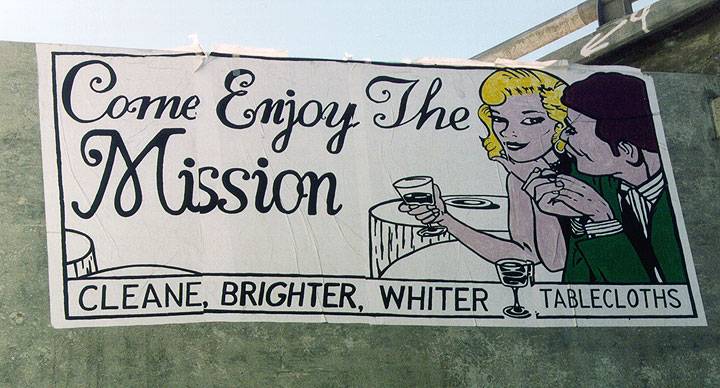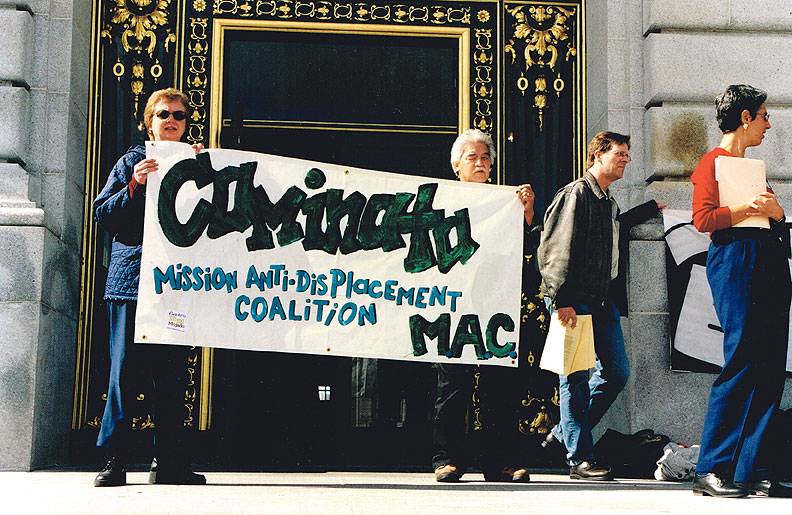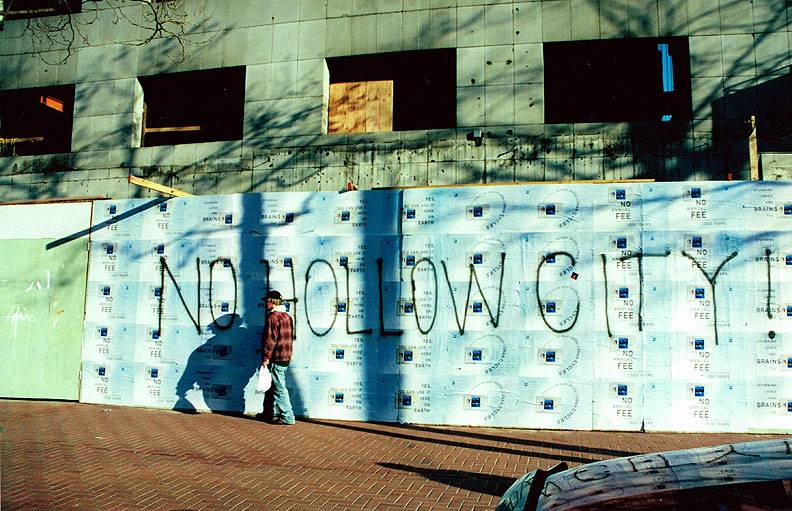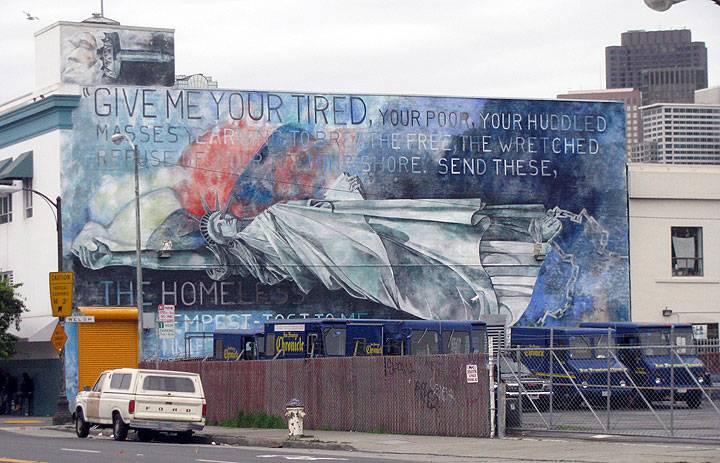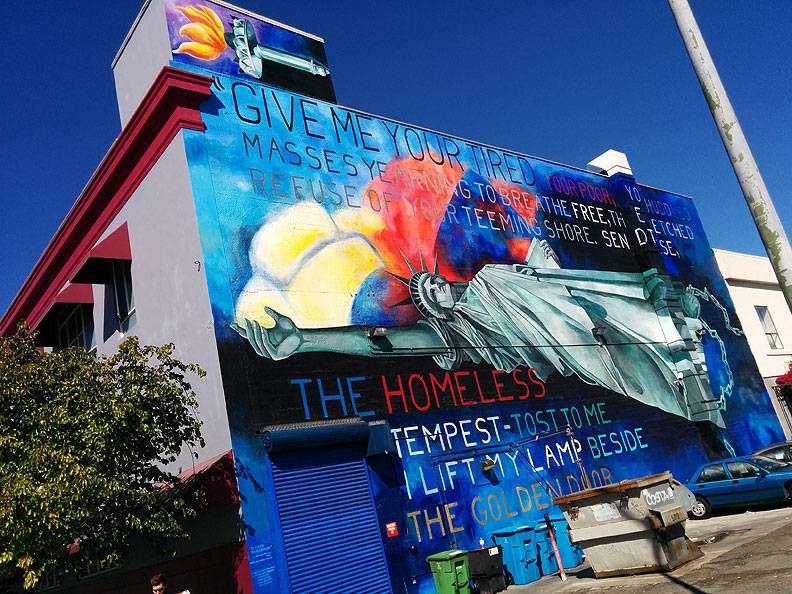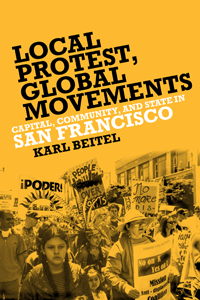Mission Anti-Displacement Coalition
Historical Essay
by Karl Beitel, 2013
Poster: San Francisco Print Collective, Photo: Chris Carlsson
| The Mission Anti-Displacement Coalition (MAC) formed in order to fight neighborhood displacement brought upon the neighborhood by the tech start-ups and evictions of the dot-com boom in the late 1990s. MAC quickly learned the importance of zoning and local government’s land use powers as a potential terrain of engagement in seeking to determine the course of neighborhood redevelopment. Neighborhood mobilization and real estate interests went head-to-head, artists began to organize around rising rents, and the MIssion increasingly became a high-tech playground with class and community tensions running high. |
The Mission Anti-Displacement Coalition (MAC) would emerge as the city’s most vocal and militant opponent of displacements brought about by the digital office conversion boom and, by the summer of 2000, was the principal protagonist leading a groundswell of neighborhood opposition to the digital makeover of the Mission. The origins of MAC can be traced back to a series of regular Monday lunch meetings in the spring of 1999 among Mission Housing, St. Peter’s, Mission Agenda, and People Organized to Demand Environmental and Employment Rights (PODER) to discuss how to respond to gentrification pressures (Feldman 2000a). Feelings of distrust had developed among these organizations over Mission Housing’s involvement with the HOPE VI renovation of Valencia Gardens, a large public housing project in the northern section of the Mission. Mission Agenda and the Eviction Defense Network, in particular, harbored suspicions that Mission Housing, in sponsoring aspects of the HOPE VI renovation, was acting as an agent for carrying out HUD policy, which was serving to expel large numbers of households from one of the city’s last remaining stocks of low-income housing. Accordingly, a goal of these meetings was to rebuild a sense of trust and begin identifying strategies that would forge a broader base of community opposition to gentrification.
MAC also reflected the shift taking place within several of the neighborhood’s nonprofits away from a service-delivery model in favor of community-based organizing. The limits of the direct-service model were becoming increasingly clear as the NASDAQ boom took off. Increased numbers of lower-income, often immigrant, Mission District residents were facing eviction threats as speculative capital flooded the neighborhood. Real estate speculation, often taking the form of housing purchases followed by eviction to convert units into private condominiums, had become more common. Rents were skyrocketing, and the housing stock of the Mission was coming under intensifying pressure from a younger, primarily white, group of newly arriving urban immigrants drawn by the dot-com boom. Activists understood that contesting gentrification would require building and sustaining a legitimate base of popular neighborhood opposition.
Parallel organizing efforts were transpiring among artists and a cluster of predominantly white activists, many of the latter having no particular organizational affiliation. Community forums held at the local performing and visual arts venue Cellspace in 1999 were attended by upwards of one hundred people. Early anti-gentrification forums were put on by the Center for Political Education that drew participation from a range of diverse neighborhood constituencies. While these forums were important in starting a dialogue, they had not as yet yielded any clear organizing strategy or coherent conception about how to unify a widely disparate set of social actors and thereby transform neighborhood anger into effective resistance.
Two specific events were crucial catalysts in the formation of MAC and would inform the subsequent tactics of the organization. The first was a seemingly minor conflict, which occurred in 1999 over a neighborhood flower shop, that provided an important lesson to an emerging generation of younger activists about the regulatory powers vested in local government over land use. Carmen Ramirez, a first-generation immigrant, began receiving complaints from several neighbors about the location of her flower shop on a sidewalk in front of an abandoned lot at Twenty-Third and Shotwell Streets. Ramirez went to the Mission Economic Development Association (MEDA) seeking assistance. News of the dispute reached activists in PODER, who were engaged in organizing campaigns among low-income immigrants and community organizers at Mission Housing. Members of MEDA and Mission Housing jointly went to the Planning Department to begin to investigate the zoning issues raised by the home owners. Ramirez was ultimately able to retain the site; what was significant about this skirmish, beyond the immediate victory, was that it began to reveal to neighborhood organizers the importance of zoning and local government’s land use powers as a potential terrain of engagement in seeking to determine the course of neighborhood redevelopment (Quezada 2002).
Bill Sorro and Betty Traynor on City Hall steps during Grant Building protest, 1999.
Photo: Chris Carlsson
The second event was a public split within the ranks of the Mission’s old guard nonprofit sector that had originally been consolidated under the Model Cities program between 1968 and 1973. The immediate context of this split was the sale of the Armory building, a large multistory structure, to property developers who proposed converting the site into a digital incubator and startup server farm. In February 2000, several nonprofits—Mission Neighborhood Centers, MEDA, Mission Hiring Hall, and Arriba Juntos—with roots in the Mission Coalition Organization, which was formed in 1968, convened a meeting of the Mission Planning Coalition to discuss the projected impact of the Armory on the Mission. Representatives from Mission Housing, St. Peter’s, PODER, and Mission Agenda were also present. When discussion turned to developers’ attempts to garner support for the proposed redevelopment through promises of monetary donations and jobs to local nonprofits, Sam Ruiz, director of Mission Neighborhood Centers, stood up and publicly accused David Bracker, director of Arriba Juntos, of “selling out the community” over deals cut with SKS Investment in return for support for a large office complex then being proposed at a site on Twentieth and Bryant Streets (Quezada 2002). The confrontation revealed a split in the older generation of established community organizations. This fissure undermined any presumption of consensus behind the pursuit of patronage strategies that sought to extract minor concessions from developers. Most important, the denouncement by Ruiz, a longtime member of the old guard, conferred legitimacy to organizations seeking to adopt a more confrontational posture in response to developers. Ruiz’s statement thus made it easier to discredit those like Bracker, who were advocating for a more conciliatory, and corporatist, approach, and allowed younger organizers to credibly claim to represent the interests of the neighborhood’s Latino constituencies in future negotiations with the local land use bureaucracy.
MAC was officially founded shortly thereafter, with the core activist-leaders drawn from Mission Housing, St. Peter’s, and PODER. MAC developed a list of demands that provided a framework for mobilizing political pressure on the San Francisco Planning Department. The demands MAC laid out stipulated a moratorium on the following: new market-rate housing and live-work lofts in the Mission, office conversion and new digital office construction, and illegal conversions and occupation of live-work lofts by Internet businesses. In addition, MAC called for the full funding of a community planning process to rezone the Mission. Four subcommittees were formed. The Base-Building Committee was to develop specific outreach campaigns and events that targeted primarily Latino and Spanish-speaking working-class households and youth. This resulted in a community forum on October 26 to provide tenant rights information to Latino and Spanish-speaking residents. The Land Use Community Planning Committee began to undertake a comprehensive survey of land use patterns in the NEMIZ area and drafted a report on shifts in land use between 1992 and 2000, which would provide the basis for rezoning recommendations aimed at protecting existing businesses and residents. Other committees that were formed included the Direct Action Committee, which planned protest events and rallies, and the Structure Committee, charged with internal logistics. The result was that by the spring of 2000, MAC was holding regular weekly meetings that began to draw in Mission District artists and large numbers of white activists without specific institutional affiliations.
The first public action coordinated by MAC occurred when activists attended Planning Commission hearings on the proposed Armory building project. Coalition members testified against the proposal on the grounds that it would exacerbate parking problems, increase housing demand, and drive up land values in immediately adjacent areas. These arguments were to no avail, and the project was given the green light by the Planning Commission.
The set of events that triggered an upsurge in neighborhood mobilization and projected MAC into the citywide political debate involved the Planning Commission’s approval of an office conversion project at Twentieth and Bryant Streets. The site had been purchased in 1999 by SKS Investment and slated for conversion into a 159,000-square-foot office complex. SKS displaced nearly sixty small businesses, nonprofits, and artists from the building, including a sweater factory, a furniture factory, a sex toy factory, a custom garment maker, a nonprofit publisher, four dozen photographers, graphic artists, sound designers, and filmmakers, including the award-winning Latina filmmaker Lourdes Partillo. Anger over the mass eviction was widespread. A Planning Commission hearing on the project was convened on May 4 at which twenty-seven activists testified against the proposed development by pointing to a host of negative “externalities” that would result if the Planning Commission approved the plan (Feldman 2000a). It was estimated that the project would generate approximately 510 new jobs but without adequate provisions made to absorb an estimated demand of 172 additional units for prospective employees seeking to reside in San Francisco. Activists cited a Planning Department Environmental Impact Report (see San Francisco Planning Department 1999a) that estimated 68 percent of those employed at the site would drive to work, in contrast to a then-citywide average of 28 percent of San Francisco residents commuting by car within the city limits. This would lead to increased traffic flow and negatively affect an already worsening parking situation in the neighborhood (San Francisco Planning Department 2000; for an analysis of options regarding land use, see San Francisco Planning Department 1999b).
Graffiti reflecting the emptying out of the city during the dotcom boom of 1999-2000.
Photo: Chris Carlsson
The Planning Commission ignored neighborhood concerns and approved the Twentieth and Bryant project. Opponents immediately filed an appeal of the Planning Commission decision that deferred final project approval to the Board of Supervisors. The board initially indicated that public hearings on the issue would take place in July or August. Backstage lobbying efforts by SKS succeeded in moving the hearing to June 26, with public notice being sent out only three days prior to the rescheduled date (CELL 2000). Outraged, MAC activists organized a protest at the June 26 hearing and asked for a two-week continuation in order to work out a compromise. The motion failed, and the eight board members, closely aligned with Mayor Brown, voted to approve the project (Newinski 2000).
The Twentieth and Bryant project catalyzed the mounting sense of outrage at the perceived favoritism shown to developers by the Planning Commission and the Board of Supervisors. Both the commission and the board were closely tied to Mayor Brown and operated largely at his behest. Their intransigence in response to the unified show of neighborhood opposition was taken as evidence of the degree to which real estate interests were dictating the planning process. Seeking to up the stakes, in June 2000 MAC organized a raucous protest in front of the Planning Department offices. Planning Department chief Gerald Green eventually appeared and agreed to attend a MAC-sponsored meeting in the Mission to hear the list of grievances. More than five hundred people turned out for a June 28 planning meeting at Horace Mann School, with neighborhood residents providing more than three hours of testimony (Feldman 2000a; Kim 2000b). MAC presented a list of demands, calling for a complete moratorium on all new development in the Mission and the creation and funding of community planning forums to allow for impact assessments and neighborhood input regarding the approval process. Green refused to agree to a moratorium on new development, while pledging support for funding a community planning process; no specifics of what this might entail were discussed. The Horace Mann meeting galvanized a new level of neighborhood opposition and allowed MAC to claim that it was the legitimate representative of the Mission community. The coalition conducted ongoing negotiations over the impacts and solutions to the problems created by the development boom. MAC would henceforth function as the lead organization representing the interests of the Mission in future dealings with developers and government officials (Kim 2000c; Feldman 2000a; Newinski 2000).
Another large-scale eviction occurred in the summer of 2000 at the Bay View Bank building located in the center of the barrio at Mission and Twenty-Second Streets. In the summer of 1999, the Bay View building had been purchased by the Cort Family trust (“Going, Going, Gone!” 1999). The Cort family was by then a major player in the high-tech makeover of the NEMIZ and had drawn the ire of Mission District residents back in 1998 for whitewashing over a five-thousand-square-foot mural on the Lilli Ann building, which the trust had purchased in the north Mission to redevelop into live-work and digital industrial spaces. The mural, which once covered the entire side of the Lilli Ann building with sharp geometrical shapes and a bright primary color scheme, is today a large, white uniform space—seen by some as a fitting emblem of the homogenizing effects of gentrification.
Groups and organizations evicted from the Bay View Bank building included a Spanish television network (Telemundo Channel 48), two Spanish newspapers (El Tecolote and El Reportero), several Spanish-speaking radio stations (Radio Unica), and numerous social service agencies and organizations serving the barrio’s working-class and immigrant populations, such as small business consulting agencies, child care referral agencies, family and immigration lawyers, and medical offices serving the local population (Constantinou 1999). The Bay View Bank building was subsequently rented to the Internet start-up Bigstep.com. In September 2000, MAC led more than sixty demonstrators to the Bigstep.com offices and, after a tense moment of confrontation with the police, succeeded in getting several executives from Bigstep.com to agree to an on-site meeting with fifteen activists. Two reporters were allowed to be present. MAC demanded that Bigstep.com apply for a conditional use permit and find equivalent space for the displaced residents. Bigstep.com responded by offering to provide 10 percent of the building to nonprofits at below-market rents. No resolution was forthcoming (Miller 2000).
Protests continued throughout the summer of 2000. On August 12, MAC sponsored a caminata (a “walk”), through the Mission district that visited sites at which evictions had taken place. The walk drew more than one thousand people representing a broad mix of Mission residents (“Caminata” 2000, 7). MAC also organized several pickets and protests over the planned conversion of the Armory building, arguing that no provisions had been made to ensure local hiring or to adequately mitigate impacts on housing and local parking access.
Body Count
Organizations housed at Twentieth and Bryant and the Bay View Bank were not the only groups suffering from displacement by the onrush of Internet commerce. The deleterious impact on artists was such that in 1999 the arts community fast-tracked a massive survey to determine the extent of the problem facing artists and nonprofit cultural agencies under duress from the boom (Hendrix 2000). Soaring rents would likewise extract a toll. The Cartoon Art Museum had to contend with a monthly rent hike of from $9,000 to $20,000, and the Dancers’ Group in the Mission District saw its rent raised from $3,000 to $15,000 per month (Newinski 2000). The Gay, Lesbian, Bisexual, Transgender Historical Society faced a sharp rent increase and struggled to find a means to stay in the city. The Names Project—the group that created the AIDS quilt— was forced from the space where the first AIDS quilt was created, at the corner of Castro and Market Streets. Communities for a Better Environment, one of the Bay Area’s largest environmental advocacy groups, was forced to move to downtown Oakland after rents in the SOMA office building in which it was located tripled overnight. Specialty stores were being forced to relocate. As one small business owner lamented, “The hardest part about this is the feeling that it’s not just here [referring to her own situation of being evicted], but everywhere, the overall homogenization of society. San Francisco was not always that way. The new people don’t know what it was like, so they don’t know what they are missing” (quoted in Hendrix 2000).
This wave of unprecedented displacement of established community institutions and small businesses has led many to bemoan what they see as the final stage in the homogenization of San Francisco. As Michael Yaki, one of San Francisco’s supervisors at the time, stated:
It [the massive dislocation of existing businesses] can bring changes as profound as any seismic event. If this market continues and the available space continues to shrink, two, three or four years down the road we will start seeing a significant difference in the profile of what’s around here. A lot of niche small businesses that can’t afford these rents will be gone in favor of only those that can pay. . . . It’s more than economic Darwinism—it’s more like a tsunami. (Quoted in Hendrix 2000)
Real estate agents remained generally unyielding. One property manager was quoted as saying:
It was difficult at first [to tell tenants of the rent increases], but after a while tenants realized that’s happened to the whole area, not just our building, and they became more educated about what the entire city is charging. (Quoted in Hendrix 2000)
Educated, perhaps, but still facing eviction.
As for the “invading” urban entrants flush with microchip gold, the attitude toward the urban spaces within which they were staking out their own territorial claims was perhaps more complex than what was often imputed by those reeling under the strains of the dot-com boom (see Slaton 1999). Many of San Francisco’s newer arrivals were drawn by the promise of urban diversity and the attraction of living in a “real” neighborhood. On the other hand, the dot-com boom brought with it an undeniable air of hubris and arrogance. Boosters of the “new dawn” envisioned themselves as cutting-edge agents of an epochal social transformation that was annihilating all established habits of thought and outmoded ways of conducting business. What was notable about the culture and ethos of the period was the ability of capitalist entrepreneurs to appropriate the language and symbols of countercultural rebellion. A pervasive ethos of “think different” infused the relentless hype that the Internet was perhaps the most significant transformative moment in the entire history of (global) capitalism. Entrepreneurialism was reconfigured as a type of transgressive practice. In this mythology of capitalism as transgression and cutting-edge rebellion, the central city was (re)presented as a site within which these newly released transformative impulses circulated through a dense network of flexible partnerships between high-tech businesses, fueled by a constant process of permanent innovation. A semiotics of “industrial chic” provided the aesthetic backdrop through which the former industrial wasteland was reappropriated as a high-tech urban playground.
Beneath the hype of business as a new form of transgression, a far more cold and repressive current was circulating through San Francisco’s eastern corridors. Those with the means to afford these spaces could live protected by high-tech security systems, with access to private interior gardens and sitting rooms, as well as off-street parking spaces protected by computer-controlled iron garages. New principles of exclusion were at work, exercised through the ability to retreat inside the security of these private and exclusionary residential spaces protected by gated security systems and brightly lit entranceways. The loft conveyed a relation of social distance and distinction. In a city suffering from an acute housing crisis, the ability to command an excess of the most scarce and desired resource—namely, residential space—and the quasi-public display of this wealth in the form of rooms with twenty-foot-high ceilings lighted by designer track lights evoked a new sense of exclusive class status and privilege. Much of the resentment generated by these buildings derived from this type of ostentatious consumption of space evoked when one looked up from the street, where relations of class privilege were symbolized by the high ceilings, the gated entrances, and the designer overhead track lighting that illuminated the interior world of the salariat, a world at once in near physical proximity and socially far away.
This mural ironically juxtaposing a fallen Statue of Liberty and its promise to the reality of mass homelessness was painted in the early 1990s by Joanna Poethig in the South of Market neighborhood.
Photo: Chris Carlsson
Same mural in 2015, restored.
Photo: Chris Carlsson
For boosters of urban revitalization, the dot-com boom was bringing economic opportunity in its wake. Money circulated through the consumption circuits, jobs became more abundant, and the rising tide would eventually lift all boats. In fact, few of the new jobs were employing existing working-class residents, and small businesses and neighborhoods serving nonprofits were being forced out. While perhaps unfortunate, such was the cost of economic and social progress, according to its most vociferous proponents. In actuality, the discourse of economic improvement often functioned to conceal a profound contempt and disregard for the poor and working class, who figured into this revitalization discourse as the disadvantaged population in need of encouragement, bolstering, and moral regeneration. This allowed boosters to reimagine gentrification as a means for providing residents of the barrio with role models and the necessary motivation to work hard and improve their lot in life.
Ironically, for all the evocation of the “cult of the new” built into the mythology of the “new economy,” we here encounter a timeworn story of the need, and indeed the imperative, for bringing the poor into contact with members of the upwardly mobile middle class. Residential cohabitation with the lower classes allows for the transmission of cultural norms that promise to lift the social and cultural level of the urban poor. Values of moral habilitation are fused with the story of the urban frontier being reclaimed by an upstanding, hardworking, and virtuous middle class. What has changed is the means through which this moralizing influence is transmitted. In place of the social work agencies and the middle-class reformers of the late nineteenth and early twentieth centuries, for whom the moral degeneracy of the working classes living in the tenements was cause for concern and in place of large-scale infusions of public money, such as those that occurred in the 1960s, the virtues of hard work and self-discipline were now transmitted through the promotion of a policy of “spatial mix” of populations of varying incomes and social stations.(2) Giving free rein to speculation and commerce is required to make way for progress. The past is thereby purged from the everyday world of the gentrifying salariat, who experience the urban world as both a site of encounter with difference and a world in need of the civilizing influence of commerce.
Excerpts from pages 68-75 and pages 85-91 from Local Protest, Global Movements: Capital, Community, and State In San Francisco by Karl Beitel. Used by permission of Temple University Press. © 2013 by Temple University. All Rights Reserved.

